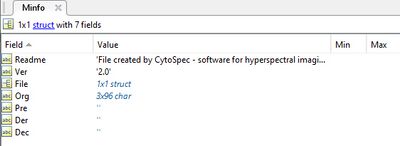Matlab Imaging Format: Difference between revisions
(Created page with "Imaging data can be considered 3-way data in which the intensity (absorbance, transmittance, reflectance, etc.) depends on two spatial [x,y] variables and one spectral variable, usually represented by the wavelength, wavenumber, or Raman shift. <br> <br> 400px|thumb| Matlab structure arrays ''C'' (imaging data) and ''Minfo'' (metadata) present in imaging data files To load imaging data in the Matlab data format select ''Load Da...") |
m (→Related links) |
||
| (One intermediate revision by the same user not shown) | |||
| Line 10: | Line 10: | ||
* [[Matlab_Trace_Format|Import data in the trace format (Matlab)]] | * [[Matlab_Trace_Format|Import data in the trace format (Matlab)]] | ||
* [[Excel_Trace_Format|Import data in the MS Excel data format]] | |||
* [[Format_of_a_2D-COS_Result_File|Format of a 2D-COS result file (Matlab)]] | * [[Format_of_a_2D-COS_Result_File|Format of a 2D-COS result file (Matlab)]] | ||
Latest revision as of 16:59, 2 April 2023
Imaging data can be considered 3-way data in which the intensity (absorbance, transmittance, reflectance, etc.) depends on two spatial [x,y] variables and one spectral variable, usually represented by the wavelength, wavenumber, or Raman shift.
To load imaging data in the Matlab data format select Load Data → Matlab imaging format → x-data or y-data to load the x-, or y-data from the Load Data menu bar. Matlab imaging data files may contain up to four different types of hyperspectral imaging data cubes: original (unprocessed data), pre-processed, derivative and so-called deconvolution data cubes (the latter 3 types of data must be derived from the original spectral data). For a detailed description of the Matlab imaging data format see [1].

